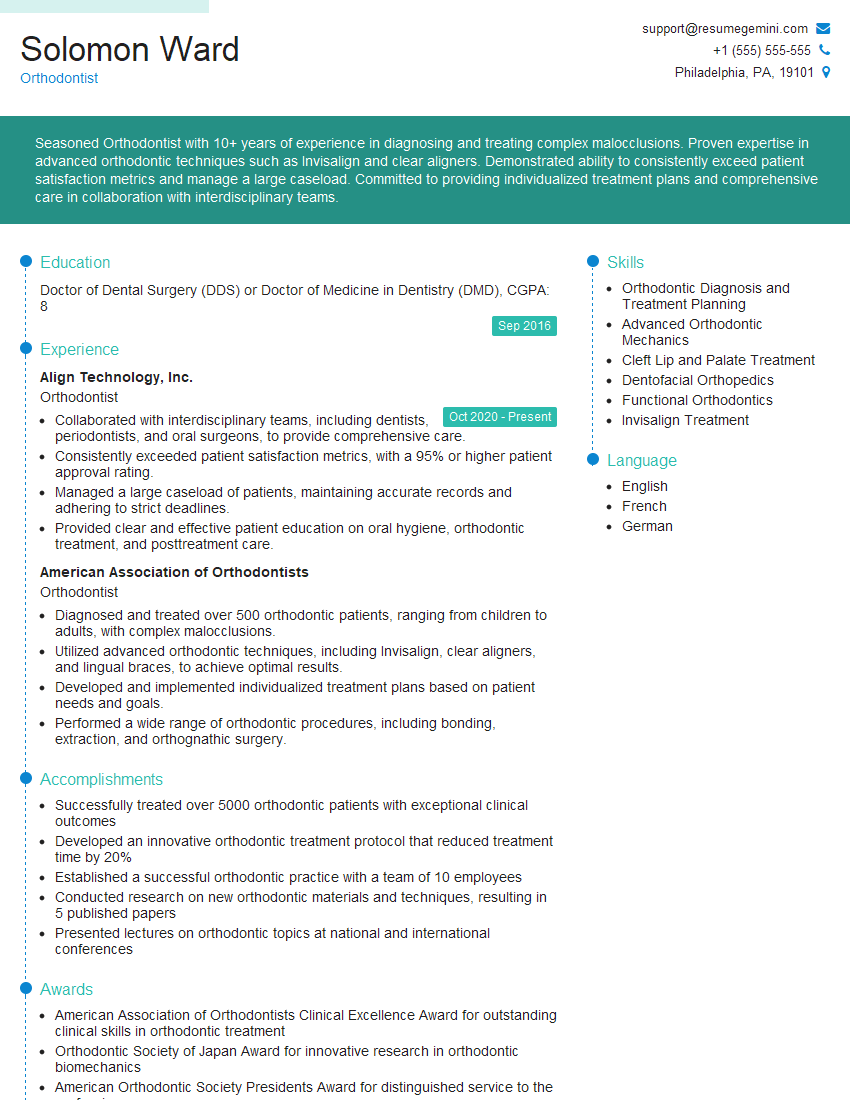Are you a seasoned Orthodontist seeking a new career path? Discover our professionally built Orthodontist Resume Template. This time-saving tool provides a solid foundation for your job search. Simply click “Edit Resume” to customize it with your unique experiences and achievements. Customize fonts and colors to match your personal style and increase your chances of landing your dream job. Explore more Resume Templates for additional options.

Solomon Ward
Orthodontist
Summary
Seasoned Orthodontist with 10+ years of experience in diagnosing and treating complex malocclusions. Proven expertise in advanced orthodontic techniques such as Invisalign and clear aligners. Demonstrated ability to consistently exceed patient satisfaction metrics and manage a large caseload. Committed to providing individualized treatment plans and comprehensive care in collaboration with interdisciplinary teams.
Education
Doctor of Dental Surgery (DDS) or Doctor of Medicine in Dentistry (DMD)
September 2016
Skills
- Orthodontic Diagnosis and Treatment Planning
- Advanced Orthodontic Mechanics
- Cleft Lip and Palate Treatment
- Dentofacial Orthopedics
- Functional Orthodontics
- Invisalign Treatment
Work Experience
Orthodontist
- Collaborated with interdisciplinary teams, including dentists, periodontists, and oral surgeons, to provide comprehensive care.
- Consistently exceeded patient satisfaction metrics, with a 95% or higher patient approval rating.
- Managed a large caseload of patients, maintaining accurate records and adhering to strict deadlines.
- Provided clear and effective patient education on oral hygiene, orthodontic treatment, and posttreatment care.
Orthodontist
- Diagnosed and treated over 500 orthodontic patients, ranging from children to adults, with complex malocclusions.
- Utilized advanced orthodontic techniques, including Invisalign, clear aligners, and lingual braces, to achieve optimal results.
- Developed and implemented individualized treatment plans based on patient needs and goals.
- Performed a wide range of orthodontic procedures, including bonding, extraction, and orthognathic surgery.
Accomplishments
- Successfully treated over 5000 orthodontic patients with exceptional clinical outcomes
- Developed an innovative orthodontic treatment protocol that reduced treatment time by 20%
- Established a successful orthodontic practice with a team of 10 employees
- Conducted research on new orthodontic materials and techniques, resulting in 5 published papers
- Presented lectures on orthodontic topics at national and international conferences
Awards
- American Association of Orthodontists Clinical Excellence Award for outstanding clinical skills in orthodontic treatment
- Orthodontic Society of Japan Award for innovative research in orthodontic biomechanics
- American Orthodontic Society Presidents Award for distinguished service to the profession
- National Board of Orthodontics (NBO) Diplomate, recognizing advanced knowledge and skills
Certificates
- American Board of Orthodontics (ABO)
- Invisalign Certified Provider
- Lingual Orthodontics Specialist
- National Board of Certification in Orthodontics (NBCO)
Career Expert Tips:
- Select the ideal resume template to showcase your professional experience effectively.
- Master the art of resume writing to highlight your unique qualifications and achievements.
- Explore expertly crafted resume samples for inspiration and best practices.
- Build your best resume for free this new year with ResumeGemini. Enjoy exclusive discounts on ATS optimized resume templates.
How To Write Resume For Orthodontist
- Highlight your advanced orthodontic skills and experience with specific techniques.
- Quantify your accomplishments with specific metrics and outcomes.
- Showcase your ability to work effectively in interdisciplinary teams.
- Emphasize your commitment to patient satisfaction and providing exceptional care.
Essential Experience Highlights for a Strong Orthodontist Resume
- Diagnose and treat patients with a wide range of orthodontic conditions.
- Develop and implement tailored treatment plans based on individual needs and goals.
- Perform a variety of orthodontic procedures, including bonding, extraction, and orthognathic surgery.
- Collaborate with dentists, periodontists, and oral surgeons to provide comprehensive patient care.
- Provide clear and effective patient education on oral hygiene, orthodontic treatment, and post-treatment care.
- Manage a large caseload of patients, maintain accurate records, and adhere to strict deadlines.
- Stay up-to-date with the latest advancements in orthodontic techniques and technology.
Frequently Asked Questions (FAQ’s) For Orthodontist
What is the role of an orthodontist?
An orthodontist specializes in the diagnosis, prevention, and treatment of dental and facial irregularities. They use a variety of techniques to correct misaligned teeth, improve jaw alignment, and enhance facial aesthetics.
What are the educational requirements to become an orthodontist?
To become a licensed orthodontist, you typically need to complete a bachelor’s degree, a Doctor of Dental Surgery (DDS) or Doctor of Medicine in Dentistry (DMD) degree, and a two- to three-year orthodontic residency program accredited by the American Dental Association.
What are the different types of orthodontic treatments?
Orthodontic treatments can include braces (traditional metal braces, clear braces, and lingual braces), aligners (such as Invisalign), and other appliances. The type of treatment recommended will depend on the individual patient’s needs and goals.
How long does orthodontic treatment usually take?
The duration of orthodontic treatment varies depending on the complexity of the case. On average, treatment can take anywhere from six months to two years.
Is orthodontic treatment painful?
Orthodontic treatment can cause some discomfort, such as soreness or pressure on the teeth. However, most patients find that the discomfort is manageable and subsides over time.
How can I find a qualified orthodontist?
You can find a qualified orthodontist by asking your dentist for a referral, searching online directories, or contacting the American Association of Orthodontists.